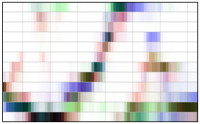Research Projects
DFG Research Fellowship: Learning Tonal Representations [WE 6611/1-1] (2021)

Learning Tonal Representations of Music Signals Using Deep Neural Networks
With the growing impact of technology, musicological research is subject to a fundamental transformation. Digitized data and specialized algorithms enable systematic analyses of large music corpora. Recently, such corpus studies were performed based on audio recordings involving methods from digital signal processing and machine learning. In this context, the tonal analysis of the music signals regarding chords, scales, or keys plays a significant role. Traditional analysis methods rely on signal processing techniques to extract tonal feature representations that indicate the presence of musical pitch classes over time, thus allowing for an explicit semantic interpretation. The objective of this project is to use deep neural networks for learning tonal representations, which are interpretable, robust, and invariant regarding timbre, instrumentation, and acoustic conditions. The project builds on complex scenarios of classical music where time-aligned scores and multiple performances of the pieces can be used for training, validating, and testing the algorithms. From a technical perspective, this project investigates approaches for learning pitch-class, multi-pitch, and salience representations. Among others, sequence learning techniques that can handle weakly-aligned annotations and U-net architectures that are inspired by hierarchical musical structures will be explored. Applying the learned representations to complex music scenarios aims for developing robust tonal analysis methods by exploiting the potential of novel deep-learning algorithms, thus paving the way towards a new level of computational music research.
Cooperating Partner / Host
- Audio Data Analysis and Signal Processing group, Department Image, Data, Signal (headed by Prof. Gaël Richard) at University Télécom ParisTech. Main supervisor: Prof. Geoffroy Peeters
DFG Project: CAS [MU 2686/7-2, KL 864/4-2] (2019 - 2022)


Computer-Assisted Analysis of Harmonic Structures (CAS)
This is a follow-up project continuing the previous DFG-funded project "Computergestützte Analyse harmonischer Strukturen" [MU 2686/7-1, KL 864/4-1]. Our interdisciplinary project deals with the development of automated techniques for the analysis of harmonic structures. On a broader level, we aim at investigating to which extent musicology may benefit from using computer-based methods and, vice versa, musicological research may introduce new scientific challenges into computer science. In addition to the development of computer-based analysis techniques, our further goal is to explore novel navigation and visualization concepts that allow researchers to browse, search, and analyze large music collections with regard to harmonic structures in an intuitive and interactive way. The concepts are paradigmatically developed, verified, and discussed on the basis of concrete music corpora. In particular, in the case of the tetralogy "Der Ring des Nibelungen" by Richard Wagner, unknown structural relationships may be discovered, thus gaining new musicological insights. In this follow-up project, we significantly extend the objectives of the previous project. By considering further parameters, we aim at expanding and refining the harmonic analyses. In addition to harmonic structures, musical aspects such as motifs, instrumentation, and performance practice as well as their interrelations are subject of our computer-assisted analyses. The two main corpora prepared in the first project phase, Beethoven's piano sonatas and Wagner's "Ring" (including the symbolically encoded scores and annotated music recordings), provide an excellent basis for these subsequent studies. The continuation of the project shall deepen a spirit of openness, mutual interest, and long-term thinking, which may serve as a positive example of interdisciplinary collaboration in the field of Digital Humanities.
Cooperating Partners
- Prof. Dr. phil. Rainer Kleinertz, Universität des Saarlandes, Institut für Musikwissenschaft
- Dr. Stephanie Klauk, Universität des Saarlandes, Institut für Musikwissenschaft
- Prof. Dr. Meinard Müller, Friedrich-Alexander Universität Erlangen-Nürnberg (FAU), International Audio Laboratories Erlangen

